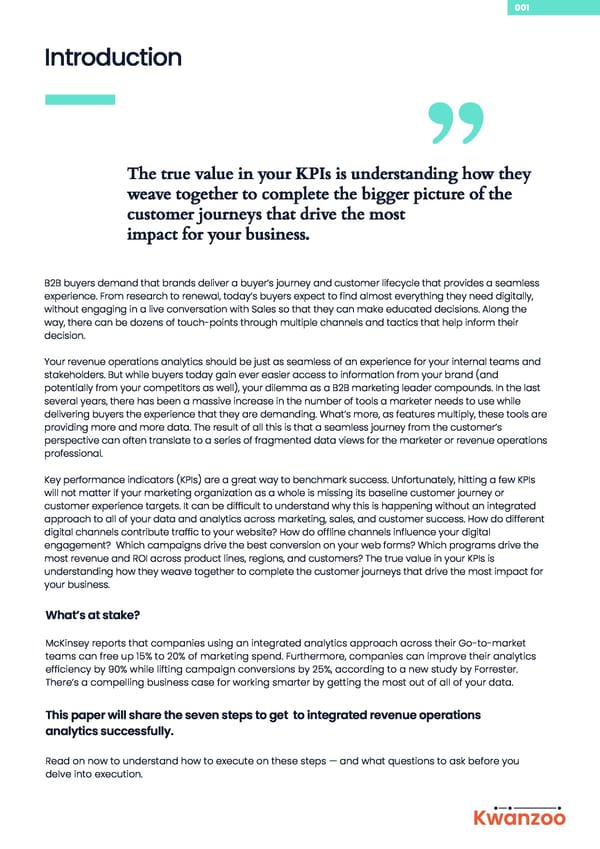001 Introduction TThe true vhe true value in yalue in your KPIs is undeour KPIs is understandrstanding hoing how thew they y wweaeavve toe togethegether to complete the bigger to complete the bigger picturr picture of the e of the ” customecustomer jr journeourneys thays that drit drivve the most e the most impact foimpact for yr your businessour business.. B2B buyers demand that brands deliver a buyer’s journey and customer lifecycle that provides a seamless experience. From research to renewal, today’s buyers expect to find almost everything they need digitally, without engaging in a live conversation with Sales so that they can make educated decisions. Along the way, there can be dozens of touch-points through multiple channels and tactics that help inform their decision. Your revenue operations analytics should be just as seamless of an experience for your internal teams and stakeholders. But while buyers today gain ever easier access to information from your brand (and potentially from your competitors as well), your dilemma as a B2B marketing leader compounds. In the last several years, there has been a massive increase in the number of tools a marketer needs to use while delivering buyers the experience that they are demanding. What’s more, as features multiply, these tools are providing more and more data. The result of all this is that a seamless journey from the customer’s perspective can often translate to a series of fragmented data views for the marketer or revenue operations professional. Key performance indicators (KPIs) are a great way to benchmark success. Unfortunately, hitting a few KPIs will not matter if your marketing organization as a whole is missing its baseline customer journey or customer experience targets. It can be difficult to understand why this is happening without an integrated approach to all of your data and analytics across marketing, sales, and customer success. How do different digital channels contribute traffic to your website? How do offline channels influence your digital engagement? Which campaigns drive the best conversion on your web forms? Which programs drive the most revenue and ROI across product lines, regions, and customers? The true value in your KPIs is understanding how they weave together to complete the customer journeys that drive the most impact for your business. What’s at stake? McKinsey reports that companies using an integrated analytics approach across their Go-to-market teams can free up 15% to 20% of marketing spend. Furthermore, companies can improve their analytics efficiency by 90% while lifting campaign conversions by 25%, according to a new study by Forrester. There’s a compelling business case for working smarter by getting the most out of all of your data. This paper will share the seven steps to get to integrated revenue operations analytics successfully. Read on now to understand how to execute on these steps — and what questions to ask before you delve into execution. Kwanzoo
 2. Revenue Operations Analytics Page 1 Page 3
2. Revenue Operations Analytics Page 1 Page 3